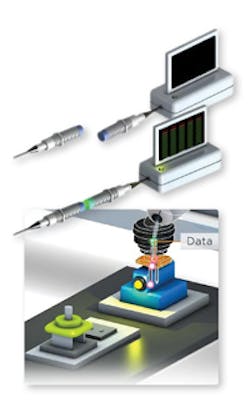Inductive charging starts to replace slip rings
Inductive power transmission is making headlines these days as a means of wirelessly recharging batteries in electric vehicles. But industrial uses are cropping up as well. The latest is in a system from TE Connectivity, Harrisburg, Pa., which lets a remote circuit draw power via a wireless connection while also beaming back digital data.
Dubbed Ariso, the wireless inductive-coupling system can transfer not just electrical power but also data (four or eight channels depending on the model) across small distances, without any contact.
One application its designers have in mind is as a means of eliminating the need for slip rings supplying power to rotating assemblies. Its designers figure the stationary pieces such as robot arms could transfer power inductively to a rotating, indexing, or fixed mobile part such as a gripper. In this way power becomes available to power sensors, heaters, cameras, valves, motors, computers, or batteries while data feeds back to the stationary piece.
TE also says its Ariso system coupling operates in such demanding environments as underwater, in vacuum chambers, in clean rooms, when surrounded by grease or mud, or on equipment spinning at high speed.
The current Ariso design is typically used for sensor applications where the bandwidth needs are limited. It can transfer digital signals at around 1 kHz. Six watts is the maximum power transfer at 24 Vdc. The design uses a dc-dc power converter which can also handle lower operating voltage levels with modifications. TE Connectivity says the devices can operate at lower voltages without affecting efficiency. Energy transfer across the inductive gap is enough to provide a continuous 250 mA at 24 Vdc, though higher peak currents are possible. The company says it can also devise units with higher power ratings on request.
Resources: TE Connectivity, http://connections.te.com/

